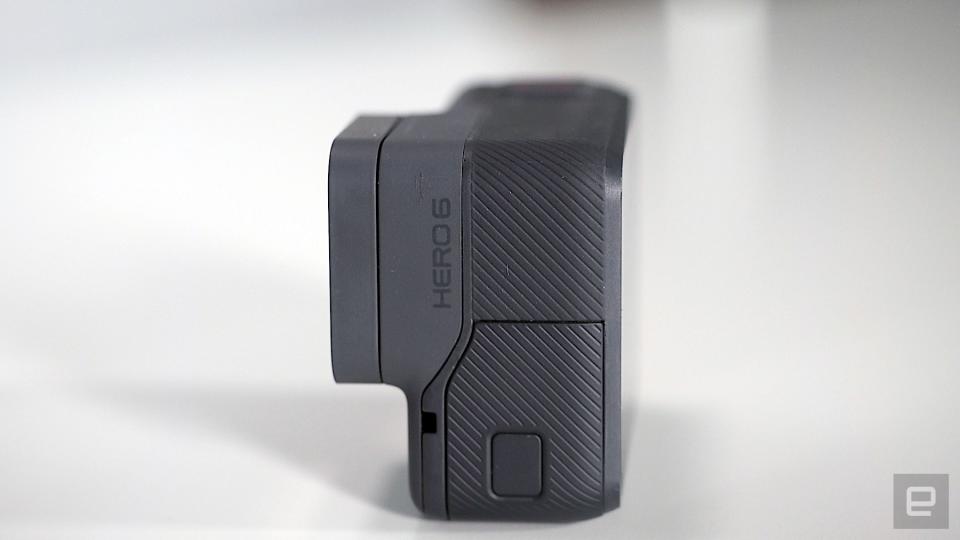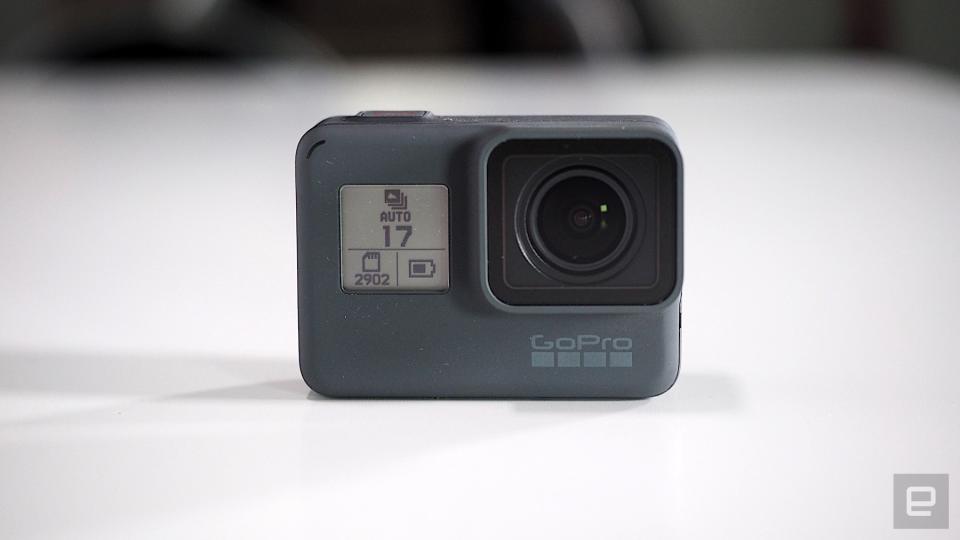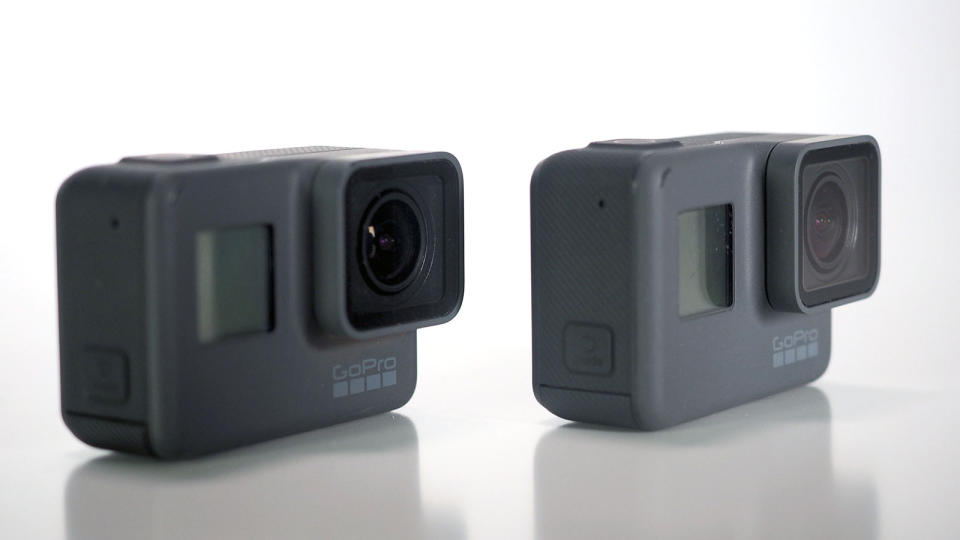GoPro Hero 6 review: Slow-mo, stabilization and subtle refinements
Sometimes it's what's on the inside that counts.
If you look at the GoPro Hero 6, it's nearly impossible to tell it apart from the Hero 5, even on close inspection. The older, silver GoPros used to have the model number marked in black text on the front. The only way to tell the most recent cameras apart is small gray-on-gray text on the left side of the camera, and the word "power" on right (replacing "mode"). I even have to hold the camera up to the light to make sure the tiny number 5 isn't a 6 (and vice versa).
But use the Hero 6 for more than a few minutes, and the improvements become apparent. There are three standout features that I think make the world of difference between these otherwise-identical GoPros. Here's what they are and why they matter.
Image stabilization (EIS)
Before the Hero 5, GoPro cameras didn't have any kind of image stabilization built in. Your options were to either make sure you have a steady hand or fix in post. The former is harder than you think depending on what you're doing; the latter is a pain in the ass for most people. The Hero 5 introduced Electronic Image Stabilization (EIS), which cropped the image 10 percent in exchange for smoother video. The EIS only worked on two axes in most resolutions, and not at all in 4K or over 60 frames per second (FPS).
EIS certainly helped smooth out your clips, but if you were moving at a certain angle, there was often notable warping or artifacts. The Hero 6 offers improved stabilization with an extra axis added, meaning diagonal/rotational movements are much less of an issue. It also works at 4K30 and up to 120fps in 1080p. The Hero 6 also has dedicated hardware to remove any warping right in the camera.
(An earlier version of this story stated the Hero 6 now only crops by 5 percent, a detail provided directly by GoPro. The company has since advised that this was not accurate, and the crop still remains 10 percent. The related sentence has been removed.)

This one feature is my favorite upgrade between the Hero 5 and the 6. I took both cameras out, mounted side-by-side under different conditions (walking, skateboarding and so on), and every time the difference between the two was stark. The Hero 6 consistently comes out looking not just smoother, but more natural, with almost no visual distortion. If you're mounting the camera in a place that's already fairly stable (your head, in a gimbal, or on a car, for example), it's better not to use EIS and keep the stabilization out of the mix. But for most hand-held recording or mounting on shaky surfaces, it's a godsend.
Professional "pixel pushers" will still lament that the stabilization is being handled by software (rather than the superior optical "OIS" method), but for most users, it's a solid tool. We'd all love OIS to come to future GoPros, of course, and maybe it's on the roadmap, but for now, the Hero 6 is close to what most people need.
Slow-mo
When the Hero 4 arrived, it ushered in the era of usable 4K for GoPro. Older cameras (the Hero 3 and 3+) could shoot in UHD, but only at low framerates (15fps), which wasn't entirely useful. The Hero 4 did 4K at 30fps, though, making it the go-to setting for maximum impact (and large file size).
Shooting in 4K still isn't all that practical for most people; even pros don't use it all that much yet, but people like to have the option. That 30-fps limit meant no chance for slow-mo, though. Your perfectly landed lazerflip would either look choppy, slowed down to 15fps or, you would have to choose a lower resolution to get smooth slow-mo. Hero 6 can shoot 4K at 60fps, giving you a modest UHD slow-mo option for the first time on GoPro. Yi's 4K+ action camera has offered this combination for a while, but it's still not that common, even in phones.

What's really useful is that every other resolution has pretty much had its framerate doubled compared to the Hero 5. Now you have options for 2.7K at 120 and FHD/1080p at 240fps. That last combination -- 1080p/240 -- is going to be your go-to slow-mo setting for anything action-related. That's an eight-fold slowdown over regular 30fps -- perfect for catching exciting moments in high definition. Note that the iPhone 8 and 8 Plus also shoot in 4K/60 and 1080/240, so if you use your phone for a second angle, you can match the slow-mo shots at the same framerates -- handy. Sadly, Google is a little behind here -- the Pixel 2 shoots only 4K/30 and 1080/120.
There's something important to note at this point. While GoPro's new camera can pump out high-framerate video, it's using HEVC compression for most of the new speeds. This file format isn't universally supported yet. Mac users, for example, can't open these files on anything other than High Sierra without downloading dedicated (and often not very good) media players. I tried the latest DivX player, which claims to do it, and ended up going in circles trying to get it to work. VLC opens the files but barely plays them (for me). Elmedia player works, but it's frankly not much use.
That's a huge inconvenience if you're a casual user and want to edit these clips (and you probably do). Until your operating system catches up, you'll need to string together a few workarounds, but with Apple also adopting HEVC in iOS 11, be sure that compatibility will improve swiftly. The upside is that HEVC helps keep file sizes down. Shooting 4K at 60fps is doubling the number of 4K frames of an already large image, so files get huge, fast. With HEVC, files are anywhere between half and 80 percent the size of h.264 (the previous encoding format) at the same framerate.
Image quality
Features like slow-mo and stabilization are nice to have, but they count for nothing if the basic image isn't good. With the Hero 6 (and its GP1 chip), GoPro has made some subtle tweaks to the image quality that should give on-the-fence upgraders a nudge over the edge. Technically, this isn't "one" feature, but rather a collection of tools and improvements that conspire to make the Hero 6's imaging capabilities superior to that of its predecessors.
The first improvement I noticed with the Hero 6 is that everything looks sharper. I flew with both cameras in the Karma and shot a landscape with water, buildings and grass, which really spelled out the differences. For example, leaves on trees are much more textured with the Hero 6, even when the Hero 5 is closer. Likewise, water in the distance appears as a fairly plain gray-blue mass on the Hero 5, but the new GoPro shows shadows and ripples that I couldn't see before. The same with the sky. Hero 6 showed a level of detail and contrast with clouds that the Hero 5 simply couldn't muster.
The sharpness is aided by improved color, too. Everything on the Hero 6 (using the "GoPro" color mode) simply pops. While flying over gravel and asphalt, the Hero 5's images looked dull and gray, while the Hero 6 showed a broader range of colors, even within the same dull parking lot.
If there's a downside to this, it's that sometimes, colors on the 6 can look too poppy. On a day out in the California sunshine, the blue of the sky was so saturated in shot that it almost looks unreal (it was very, very blue, but still). There is a natural/flat color mode if you find the GoPro levels not to your liking, but in general use, it wasn't unnatural. Side note: The Hero 6 now has an HDR mode for still photos (the Hero 5 has something called "WDR"). This is good news for those who want to take snaps, but also an encouraging sign that we might get HDR video in the future.

You have to dig a little deeper into the settings, but there are a few options that also bolster the Hero 6's image cred. GoPro's "ProTune" menu has had advance controls over your exposure for a while, but the shutter speed and white-balance menus now offer more options, allowing you to dial in your shot, and ISO control has been split into min/max rather than the single max option from before. Small details, for sure, but for those who like to get hands-on with their settings, these really make a difference. I personally like being able to lock the ISO to a set number, making sure I get the sharpest image possible at all times.
The last feature in this section is the new linear-zoom option. Before, you basically chose between narrow, medium or wide FOV. With the Hero 6, you use a slider to dial in the amount of zoom/field of view that you want, giving you much more control over what's in the shot. The good news is that zoom also works with the horizon-friendly Linear mode, too. Being able to digitally frame your shot via the camera is a godsend for casual users (pros will likely prefer to do that in post).

So, it's hardly a surprise that the Hero 6 is better than the Hero 5. But it's better in important ways, rather than just "lots" of (less important) ways. Voice control and other auxiliary features are nice, but it's good ol' photography that really matters, and there's enough improvement here that I think it warrants the upgrade.
That said, the Hero 6 is pricier than the Hero 5, which retains its $399 launch price to this day. You'll have to cough up an extra $100 for all the features I mentioned above, making the Hero 6 an expensive investment for most people. Most of the features mentioned here are available on rival cameras, but with trade-offs. Sony's $400 X3000 has better (OIS) stabilization but lacks many of the higher framerate options. The budget Yi 4K+ cam ($300) offers 4K/60, but the GoPro still bests it for slow-mo at most other resolutions, but it's always worth looking at those to see if they suit your needs too. But at the end of the day, if you want a GoPro, the choice is clear, even if it comes at a price.

























